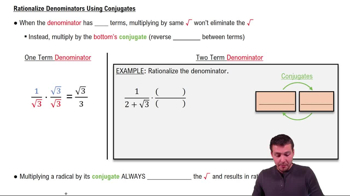Table of contents
- 0. Review of College Algebra4h 43m
- 1. Measuring Angles39m
- 2. Trigonometric Functions on Right Triangles2h 5m
- 3. Unit Circle1h 19m
- 4. Graphing Trigonometric Functions1h 19m
- 5. Inverse Trigonometric Functions and Basic Trigonometric Equations1h 41m
- 6. Trigonometric Identities and More Equations2h 34m
- 7. Non-Right Triangles1h 38m
- 8. Vectors2h 25m
- 9. Polar Equations2h 5m
- 10. Parametric Equations1h 6m
- 11. Graphing Complex Numbers1h 7m
0. Review of College Algebra
Rationalizing Denominators
Problem 51b
Textbook Question
Add or subtract, as indicated. See Example 4. 1 2 4 —— + —— + —— 6m 5m m
 Verified step by step guidance
Verified step by step guidance1
Identify the least common denominator (LCD) for the fractions. The denominators are \(6m\), \(5m\), and \(m\).
The LCD is the least common multiple of the denominators. Since all denominators have \(m\), focus on the numerical coefficients: 6, 5, and 1. The LCM of 6, 5, and 1 is 30.
Rewrite each fraction with the LCD as the new denominator. Multiply the numerator and denominator of each fraction by the necessary factor to achieve the LCD.
For \(\frac{1}{6m}\), multiply by \(\frac{5}{5}\) to get \(\frac{5}{30m}\). For \(\frac{2}{5m}\), multiply by \(\frac{6}{6}\) to get \(\frac{12}{30m}\). For \(\frac{4}{m}\), multiply by \(\frac{30}{30}\) to get \(\frac{120}{30m}\).
Add the fractions by combining the numerators over the common denominator: \(\frac{5}{30m} + \frac{12}{30m} + \frac{120}{30m} = \frac{5 + 12 + 120}{30m}\).
Recommended similar problem, with video answer:
 Verified Solution
Verified SolutionThis video solution was recommended by our tutors as helpful for the problem above
Video duration:
2mPlay a video:
Was this helpful?
Key Concepts
Here are the essential concepts you must grasp in order to answer the question correctly.
Common Denominator
To add or subtract fractions, it is essential to have a common denominator. The common denominator is a shared multiple of the denominators of the fractions involved. In this case, for the fractions 6m, 5m, and m, the least common multiple must be determined to combine them effectively.
Recommended video:

Rationalizing Denominators
Fraction Addition/Subtraction
Adding or subtracting fractions involves combining the numerators while keeping the common denominator. The formula for this operation is (a/b) + (c/d) = (ad + bc) / bd. Understanding how to manipulate the numerators and maintain the denominator is crucial for accurate calculations.
Recommended video:

Solving Linear Equations with Fractions
Simplifying Fractions
After performing addition or subtraction on fractions, the result may need to be simplified. Simplifying involves reducing the fraction to its lowest terms by dividing both the numerator and denominator by their greatest common divisor (GCD). This step ensures the final answer is presented in the simplest form.
Recommended video:

Solving Linear Equations with Fractions

 2:9m
2:9mWatch next
Master Introduction to Trigonometry with a bite sized video explanation from Nick Kaneko
Start learning



